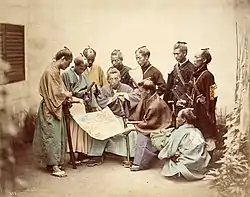
The Boshin War was a civil war in Japan, fought from 1868 to 1869 between forces of the ruling Tokugawa shogunate and those seeking to return political power to the imperial court. The war found its origins in dissatisfaction among many nobles and young samurai with the shogunate's handling of foreigners following the opening of Japan the prior decade. An alliance of southern samurai and court officials secured the cooperation of the young Emperor Meiji, who declared the abolition of the two and a half century old shogunate. Military movements by imperial forces and partisan violence in Edo led Tokugawa Yoshinobu, the sitting shogun, to launch a military campaign to seize the emperor's court at Kyoto. The military tide rapidly turned in favor of the smaller but relatively modernized imperial faction, and after a series of battles culminating in the surrender of Edo, Yoshinobu personally surrendered. The Tokugawa remnant retreated to northern Honshū and later to Hokkaidō, where they founded the Ezo republic. Defeat at the Battle of Hakodate broke this last holdout and left the imperial rule supreme throughout the whole of Japan, completing the military phase of the Meiji Restoration. Around 120,000 men were mobilized during the conflict, and of these about 3,500 were killed. In the end, the victorious imperial faction abandoned its objective to expel foreigners from Japan and instead adopted a policy of continued modernization with an eye to eventual renegotiation of the Unequal Treaties with the Western powers. (Full article...)